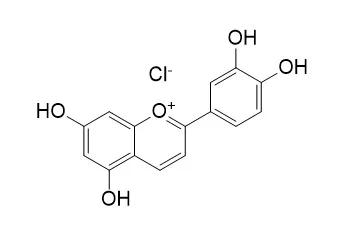| In vitro: |
| Journal of Food Biochemistry, 2010, 32(5):576-596. | | Anthocyanin Interactions with DNA: Intercalation, Topoisomerase I Inhibition and Oxidative Reactions.[Pubmed: 19924259] | Anthocyanins and their aglycone anthocyanidins are pigmented flavonoids found in significant amounts in many commonly consumed foods. They exhibit a complex chemistry in aqueous solution, which makes it difficult to study their chemistry under physiological conditions.
METHODS AND RESULTS:
Here we used a gel electrophoresis assay employing supercoiled DNA plasmid to examine the ability of these compounds (1) to intercalate DNA, (2) to inhibit human topoisomerase I through both inhibition of plasmid relaxation activity (catalytic inhibition) and stabilization of the cleavable DNA-topoisomerase complex (poisoning), and (3) to inhibit or enhance oxidative single-strand DNA nicking. We found no evidence of DNA intercalation by anthocyan(id)ins in the physiological pH range for any of the compounds used in this study-cyanidin chloride, cyanidin 3-O-glucoside, cyanidin 3,5-O-diglucoside, malvidin 3-O-glucoside and
Luteolinidin chloride. The anthocyanins inhibited topoisomerase relaxation activity only at high concentrations (> 50 muM) and we could find no evidence of topoisomerase I cleavable complex stabilization by these compounds. However, we observed that all of the anthocyan(id)ins used in this study were capable of inducing significant oxidative DNA strand cleavage (nicking) in the presence of 1 mM DTT (dithiothreitol), while the free radical scavenger, DMSO, at concentrations typically used in similar studies, completely inhibited DNA nicking.
CONCLUSIONS:
Finally, we propose a mechanism to explain the anthocyan(id)in induced oxidative DNA cleavage observed under our experimental conditions. |
|






 Cell. 2018 Jan 11;172(1-2):249-261.e12. doi: 10.1016/j.cell.2017.12.019.IF=36.216(2019)
Cell. 2018 Jan 11;172(1-2):249-261.e12. doi: 10.1016/j.cell.2017.12.019.IF=36.216(2019) Cell Metab. 2020 Mar 3;31(3):534-548.e5. doi: 10.1016/j.cmet.2020.01.002.IF=22.415(2019)
Cell Metab. 2020 Mar 3;31(3):534-548.e5. doi: 10.1016/j.cmet.2020.01.002.IF=22.415(2019) Mol Cell. 2017 Nov 16;68(4):673-685.e6. doi: 10.1016/j.molcel.2017.10.022.IF=14.548(2019)
Mol Cell. 2017 Nov 16;68(4):673-685.e6. doi: 10.1016/j.molcel.2017.10.022.IF=14.548(2019)